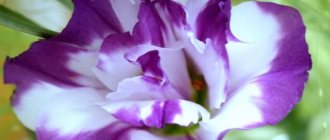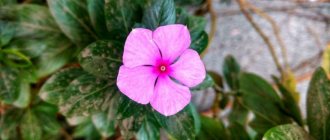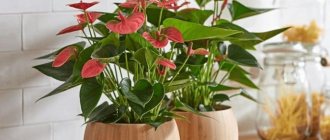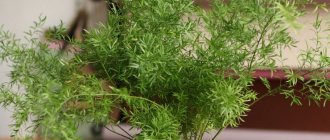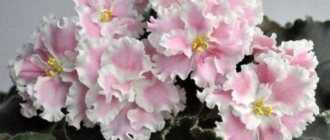Many people know the eustoma flower under another name: Japanese or Irish rose, Texas bell, lisianthus - a bitter flower. In Latin, “eustoma” sounds like “beautiful speaker” or “beautiful mouth.” Due to its beautiful appearance, the plant is often depicted on the main pages of floriculture publications.
Eustoma belongs to the Gentchavkov family. The flower's homeland is considered to be the north of South America, the south of North America, Mexico and the Caribbean islands. The American Indians keep a legend about a flower that bloomed for the first time on the grave of a girl. Refusing to become the beloved of the spirit of war, the innocent beauty turned out to be his victim. Europeans learned about this wonderful flower thanks to the Irish doctor and botanist Patrick Brown. Eustoma can not only decorate apartment window sills, but can also be stored in water for about three weeks when cut. The flower began to be planted as a houseplant about a hundred years ago. Flower growers love this plant for its beautiful flowering and try to grow it at home.
Description of the plant
Eustoma is a very beautiful decorative flowering indoor plant of the Gentian family. These flowers are still often found in the southern regions of Mexico, in the south of North America and the north of South America, on the islands of the Caribbean. Eustoma is translated from Latin as beautiful mouth.
An American Indian legend says that Eustoma first bloomed on the grave of an innocent girl who refused reciprocity to the God of War and was killed by him for this.
This wonderful flower was discovered for Europeans by the Irish doctor and botanist Patrick Brown. Under natural conditions, it is a biennial herbaceous plant with an erect stem up to 60 cm high. The leaves are whole, large, greenish with a bluish tint. Flowers are bright, blue, single.
Cultivated varieties of Eustoma appeared relatively recently. They, unlike wild species, have flowers of different colors. This is the merit of numerous breeders. Varieties with two-color colors and double flowers appeared. New varieties are being actively developed by breeders in Japan and the USA. Their Eustomas no longer look like bluebells from the wild prairies.
The appearance of the bush and its flowers, of extraordinary beauty and grace, conquer the hearts of flower growers. The tall, stable stem, similar to the stems of another flower - the carnation, has an elegant shape and is strewn with green leaves with a bluish tint, with a slight waxy coating on them. Somewhere, from the middle of the length of the bush, the stem begins to branch. During flowering, each bush gains from 30 to 35 buds and looks like an unusually beautiful bouquet.
Bicolor eustoma
The buds open alternately, one after another, and stay on the stem for a long time. The flowers, reminiscent of roses in shape, have a large, funnel-shaped, deep cup. Their petals are colored, depending on the variety, in different colors. Eustomas are snow-white, blue, yellow, pink, lilac, purple, violet, lilac, dark burgundy. It is impossible to list all the colors that nature has given to this extraordinary flower!
There are bicolor Eustomas with simple or double flowers. Only about 60 varieties are known. More than half of them are tall species for growing in the garden. At home, low-growing varieties of Eustoma are usually grown as a houseplant.
Varieties
Low-growing varieties of Eustoma include:
- Eustoma Riddle is a low compact bush, reaching 20 cm in height. Blooms profusely with double light blue flowers.
- The Mermaid variety is a miniature compact species of Lisianthus, the crown height of which does not exceed 15 cm. It does not require pinching. This hybrid blooms with simple flowers with a diameter of up to 6 cm in a variety of shades: white, light pink, lilac and blue.
- Little Bell is a densely branching bush of miniature size, reaching a height of 15 cm. The flowers are small, simple, funnel-shaped, of all kinds of colors. This variety is valued for its abundant, long-lasting flowering. You don't have to do pinching.
- Eustoma Fidelity is a low indoor plant, no higher than 20 cm in height. It is distinguished by a multitude of snow-white small flowers, which are arranged in a spiral on the flower arrow.
- Variety Tenderness is a beautiful bush with an elegant stem up to 20 cm, on which satiny petals are arranged in a spiral. Blooms with pink flowers.
- The Little Mermaid has very small bushes, up to 15 cm in height, blooming with white, light blue or pink flowers.
- Eustoma "Florida Blue" - characterized by abundant blue flowers.
- Variety Florida Pink - this very beautiful, low indoor flower blooms profusely with light pink flowers. In a pot it looks like a bouquet with wonderful miniature roses.
This may be interesting: Zephyranthes (Upstart) - home care
Little Bell Mermaid The Little Mermaid Fidelity Florida Blue Florida Pink
In addition to low-growing ones, flower growers also practice growing tall indoor Eustomas:
- Eustoma Cinderella - bush height up to 50 cm. Blooms with double flowers of delicate pink or yellow color.
- Variety Twinkie - stem height is not higher than half a meter. It blooms with white, yellow, pink or purple flowers of extraordinary beauty.
- Eustoma "Mariachi Lime" - the height of the bush reaches a meter. The flowers on it are double lime-colored.
- Echo is a medium bush, grows up to 70 cm in height. Flowers of pink, yellow, lilac or white are displayed on a strong stem.
Twinks Mariachi Lime Echo
The most popular Eustoma varieties for growing at home are large-flowered. Their inflorescences consist of many large beautiful skirt-shaped flowers of the most impossible colors: snow-white and purple-red, violet and lilac, lilac and light yellow, blue and light blue.
Caring for Eustoma at home
Indoor lighting
The place for the pot should be chosen on a well-lit, preferably southern, windowsill. But in the hot summer, the plant must be protected from direct sunlight - the lighting should be diffused to avoid burns to the delicate petals and leaves. Lisianthus is a long-day plant. In winter, it should be illuminated for at least 12 hours with fluorescent lamps.
Growing temperature
This flower loves warmth; its growing temperature should not be lower than 20 degrees. and above 24 gr. Celsius. At this temperature, Eustoma will bloom every year, and at an average room temperature of 27-30 degrees. Celsius, the flower will grow like a biennial plant - it will form buds in the first year and bloom the next year. At a constant low temperature, below 15 degrees. Celsius, the flower will slow down its growth, stop developing and may get sick.
Soil composition
Purchased soil for flowering Saintpaulias (Violets) is well suited for the soil. Good drainage is required. If you want to prepare your own soil mixture for growing Eustoma, mix equal amounts of garden soil, coarse river sand and humus. Add a little lime. It is necessary to monitor the pH (acidity) level of the soil. It should be within 6.5 – 7.0. More acidic soil can lead to zinc toxicity and the plant will slow down its growth. For normal growth of indoor Eustoma, regular ventilation of the room is necessary and important.
This may be interesting: Bauhinia: growing an orchid tree at home
Watering
Lisianthus is not often watered with warm, settled water, as the top layer of soil dries 2 cm. There is no need to spray the flower so as not to provoke the appearance of pests and diseases.
Top dressing
Eustoma loves to be fed during active growth and the appearance of numerous buds. Suitable fertilizer for decorative flowering indoor plants or any liquid fertilizer for indoor flowers. Read instructions for use on the packaging. More often it is 10 g - 15 g. fertilizers in a bucket of warm, settled water.
Eustoma bloom
Eustoma blooms in January-February, and for a long time and abundantly. The flowers bloom in turn, one after another. Don’t forget to pick off faded buds and dried leaves so that the flower always looks neat and decorative. When the flowering of the home rose ends, its dormant period begins. The plant is pruned, leaving only part of the shoots with a couple of internodes. The pot with the flower is transferred to a cooler room - with a temperature no higher than 15 degrees. Celsius, water less often and do not feed.
After a couple of months, with the arrival of spring, new leaves begin to appear on the bush - then our sissy, Eustoma, is returned to its previous warm, bright place, watering and fertilizing are resumed. Very soon your pet will grow new leaves and buds. Once again you will be enchanted by its colorful blooms.
How to properly care
Eustoma is a non-capricious plant, and caring for it consists of regular watering, periodic fertilizing and loosening the soil in the flowerbed. When grown in open ground, the crop does not tolerate winter even with good shelter. But you can transplant it into a pot and save it until next spring.
Priming
Eustoma (growing and caring in open ground will not cause much trouble) prefers loose, fertile soil with good air and moisture permeability, neutral or slightly alkaline reaction. It is important to prepare the flower bed before planting flowers. To do this, you need to dig up the area to a depth of 30-40 cm, and then add compost or humus to it.
If the soil is clayey, then it should be mixed with sand. If the acidity of the soil is increased, then you will need to add dolomite flour to it. But then you can plant the plant on the site no earlier than next summer.
Top dressing
The first time you will need to fertilize is a month after planting the seedlings in open ground.
In the future, you will need to fertilize the eustoma once every 2 weeks throughout the growing season and it is better to adhere to the following application schedule:
- At the beginning of the growing season (in June), it is advisable to use water-soluble compounds, which contain a predominance of nitrogen. Suitable ammonium nitrate, drugs Kemira Lux, Plantofol Rost, Urea.
- From July to August, eustoma should be fed with phosphorus compounds. The flower responds well to the preparations Kemira Lux, Aquarina, Polyfid, superphosphate, diammophos.
- At the end of the growing season, it is worth using potassium-phosphorus fertilizers. These include the drugs Agricol, Fertika, Plantefol Budding, potassium monophosphate.
It is better to apply fertilizers to the soil in cloudy, cool weather. If this is not possible, then it is worth moving the event to early morning or late evening. Also, it is necessary to apply preparations only after abundant watering.
Watering
Eustoma is a moisture-loving plant and must be watered regularly. But at the same time, you should not allow moisture to stagnate at the roots, because this is fraught with the occurrence of rot. Ideally, you need to water the flower at the moment when the soil in the flowerbed dries 1-2 cm deep.
On average, in spring and autumn this event will need to be carried out 1-2 times a week.
In summer, especially in dry times, it should be done every other day. However, you should not use water taken directly from a well, as cold moisture will have a bad effect on the condition of the plant’s roots. So it’s worth preheating the water in the sun to a temperature of +15...+20 °C, or even better, letting it sit for 24 hours.
The watering procedure itself must be carried out early in the morning or late in the evening. Otherwise, under the influence of the sun, the water will become very hot, which will lead to overheating of the root system of the flower. Also, during the process, moisture should not be allowed to get on the leaves and buds of eustoma - they react poorly to this. For this reason, you should not sprinkle the plant.
Loosening and mulching
After watering or rainfall, be sure to loosen the soil, otherwise a dense crust will form on it, which will prevent aeration of the root system. But this activity should be carried out carefully, going 1-2 cm into the soil. Otherwise, the roots of the flower can be damaged.
During loosening, it is also worth weeding and removing all weeds. They not only draw nutrients from the soil, slowing down the development of eustoma, but are also carriers of diseases and pests.
To reduce plant maintenance, it is advisable to mulch the soil surface with peat, sawdust or pine needles. A layer of these materials will prevent rapid evaporation of moisture and prevent weeds from developing. Mulch also prevents soil compaction, protects plants from pests, such as slugs, and improves soil composition.
Reproduction of Eustoma
Reproduction of indoor Eustoma occurs only with the help of seeds. Reproduction of Eustoma by cuttings, layering and dividing the bush is not possible.
Growing Lisianthus from seeds
Growing Eustoma begins with purchasing quality seeds.
If you are going to use the seeds of your faded plant, keep in mind that they only become suitable for planting after a year .
You can plant seeds for growing Eustoma at any time of the year, but it is better in June-July, so that by autumn the bush will form and bloom profusely and colorfully in winter. Quite a long time passes from the moment the seeds are planted to the start of flowering.
Eustoma seeds
Eustoma's seeds are very small - there are more than 10 thousand of them in one gram. Therefore, it is better to purchase Eustoma seeds in special capsules, in which a nutritious mixture of peat, sand and fertilizer are balanced for maximum effective seed germination. Place seed capsules in prepared, well-moistened soil (in a pot or container) at a distance of at least 5 cm from each other. Cover with transparent film. Place in a warm, bright place to germinate seeds.
You can also purchase the seeds in yeasted form. There, several seeds are placed in one ball with a nutrient mixture. It is convenient to sow such peas as described above. Or you can plant Eustoma seeds for seedlings in peat tablets. The container with tablets maintains the necessary humidity and temperature, it is convenient to ventilate, it is clearly visible how the seeds germinate and the seedlings develop.
Yeasted eustoma seeds
If you decide to plant your seeds for seedlings in a container or container with nutritious soil, a mixture of sand and peat in equal parts is suitable for you. Place the seeds on the surface of moist soil and press them lightly. Cover the container with transparent film or a lid.
This may be interesting: Calceolaria indoors - growing from seeds and care
The first shoots will appear no earlier than in 2-3 weeks. The soil should not be too dry or too wet. It is better to moisten the soil after the first shoots appear in the morning - there is a risk of blackleg disease. To prevent the disease, you can spray Eustoma seedlings with a solution of foundationazole - 1 tsp. for 1 liter of warm water. When the sprouts begin to sprout, begin to accustom them to new conditions - open the film more often for ventilation, reduce watering. Spray with Zircon or Epin for rapid growth of sprouts, since in the first months Eustoma grows very slowly.
Growing Eustoma in peat tablets
Only after a couple of months, when the seedlings have grown a little, can they be transplanted into separate pots. It is necessary to replant by picking up the sprout along with a lump of earth, trying not to damage the fragile roots of the tiny bush. If the seedlings are sitting in a peat tablet, carefully remove the tablet from the shell and place it in a container with prepared soil.
Transfer
Although Lisianthus is a perennial flower, it does not tolerate transplantation; try not to disturb its root system without good reason.
Replanting grown bushes in the garden
No gardener recommends replanting lisianthus unless absolutely necessary. If they still have to, then they are treated like large trees:
- Draw a contour along which the plant will be dug.
- Carefully pry up the bush from below and dump it on the surface.
- If some of the roots are damaged, they are treated with crushed charcoal or ash.
- Prepare a corresponding hole in another place, sprinkle it with ash, and spray it with fungicide.
- They lower the bush with a lump of earth and dig it in.
After this procedure, the plant must be quarantined.
It is advisable to provide him with a translucent film shelter with a small gap for air. In this case, there is a chance that some rare variety will survive.
Diseases
Of the many diseases of indoor plants, the most dangerous for Eustoma are the following: fusarium, powdery mildew, gray rot and blackleg.
Powdery mildew on plant petals
The cause of these diseases can be increased soil moisture, low ambient temperature, as well as lack of regular ventilation of the room. It is possible to protect yourself from them with the help of the drugs Fundazol and Ridomir Gold (instructions on the package), which need to be sprayed on our pets in a timely manner, in order to prevent the disease.
Treatment of young Eustoma bushes with Zircon and Epin accelerates their growth, enhances vitality and prevents the appearance of diseases such as blackleg.
Pests
Occasionally, Eustoma is affected by thrips, spider mites and whiteflies. Their occurrence is facilitated by incorrect watering of the plant, low lighting, low temperature of the flower, and infrequent ventilation of the room.
If pests are found, take the pot with the affected flower to the bathroom and carefully wash the areas where insects have accumulated with warm water. You will wash away most of the parasites. After a few days, treat Lisianthus with a suitable insecticide (Aktara, Aktellik or Fitoverm are suitable), because you are unlikely to get rid of all pests in one go. The frequency and dose are usually written on the packaging.
Growing seedlings
In principle, growing eustoma seedlings is not difficult
However, it is very important to maintain conditions that allow you to grow high-quality sprouts. If you follow all the instructions, on the 10th–12th day you will be able to see the first shoot emerge
It is at this moment that the gardener will feel proud of himself and his capabilities. Only in this euphoria, in no case should you forget to monitor your blossoming “children”.
Picking
With the onset of 2 months of age, eustomas must be subjected to a picking procedure. To do this, you will need to prepare containers, for example, small pots or paper cups. The dishes must be treated with a weak solution of potassium permanganate. After that, drainage is laid out at the very bottom of the pots. This could be pebbles, expanded clay or pieces of broken brick. Soil is poured on top of the drainage layer. Its composition should be the same as that used when planting the seeds. Using a toothpick, match or pencil, you need to make small indentations.
The container with the grown seedlings is watered with settled water. Then, using a spatula, you should remove the strongest shoots from the total mass and carefully move them into prepared containers for picking.
Top dressing
During the first two months of its life, eustoma develops extremely slowly. The first leaves of seedlings appear 6 weeks after emergence. But this does not mean that seedlings need feeding. The presented periods correspond to the normal development of lisianthus. And the soil used for planting contains all the necessary minerals and nutrients, which are sufficient for the plant.
Transshipment
As soon as the first 6–8 leaves of young seedlings have blossomed, they should be transplanted into larger containers, for example, pots or cups with a volume of 0.5 liters. The transplantation process is similar to the picking procedure. The main thing is to carefully remove the sprouts so as not to damage the young root system.
Subsequent care of transplanted plants is not difficult
It is important to monitor the moisture content of the soil and water as necessary. The same goes for feeding
